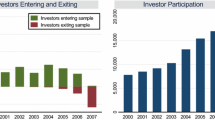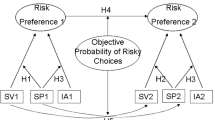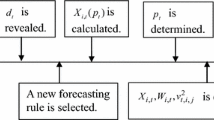Abstract
A model is developed to explain why most firms die in the first few years of trading. A risk averse entrepreneur with initial capital endowment faces a Brownian motion in net worth over time. To balance return (profits growth) and risk (variance of profits) she adopts a portfolio strategy, choosing market positioning to achieve an optimal combination of risk and return at each instant, given her financial and human capital endowments and attitude towards risk. Failure occurs when the firm’s value falls below the opportunity cost of staying in business. The resulting distribution of failure is Inverse Gaussian, implying, for specific parameter values, a positively skewed failure curve of the type observed in practice. In addition the model presents a novel-measure of management human capital (MHC) which implies that high MHC entrepreneurs will have higher absolute and marginal profits growth than low MHC entrepreneurs at given levels of risk.
Similar content being viewed by others
References
J. Aitcheson J. A. C. Brown (1957) The Lognormal Distribution Cambridge University Press Cambridge
D. Audretsch (1991) ArticleTitle‘New Firm Survival and the Technological Regime’ Review of Economics and Statistics 68 IssueID3 520–526
David B. Audretsch (1994) ArticleTitle‘Business Survival and the Decision to Exit’ Journal of the Economics of Businesss 1 IssueID1 125–138
David B. Audretsch Mahmood Talat (1995) ArticleTitle‘New Firm Survival: New Results using a Hazard Function’ Review of Economics and Statistics 77 IssueID1 97–103
Agarwal, Rashree and David B. Audretsch, 2001, ‘Does Entry Size Matter? The Impact of the Life Cycle and Technology on Firm Survival’, Journal of Industrial Economics XLIX(1), (March), 21–44
Timothy Bates (1990) ArticleTitle‘Entrepreneur Human Capital Inputs and Small Business Longevity’ Review of Economics and Statistics LXXII IssueID4 551–559
Joseph Bruderl Preisendorfer Peter Ziegler Rolf (1992) ArticleTitle‘Survival Chances of Newly Founded Business Organisations American Sociological Review 57 IssueID2 227–242
D. R. Cox H. D. Miller (1965) The Theory of Stochastic Processes Chapman and Hall London
Cressy C. Robert (1983) ArticleTitle‘Goodwill, Intertemporal Price Dependence and the Repurchase Decision’ The Economic Journal 93 847–861
Cressy, Robert C., 1993, The Startup Tracking Exercise: Third Year Report, prepared for National Westminster Bank of Great Britain, November
Robert Cressy (1996) ArticleTitle‘Are Business Startups Debt-rationed?’ The Economic Journal 106 IssueID438 1253–1270
Cressy, Robert C., 1999, ‘Small business failure: failure to fund or failure to learn by doing?’, in Acs, Z. Carlsson and Charlie Karlsson (eds) Entrepreneurship, SMEs and the Macro Economy,1977, Cambridge: Cambridge University Press
Delmar, F., 1995, ‘Risk management of the entrepreneur’, in Bo Green (ed.), Risk Behaviour and Risk Management, Proceedings of the First International Stockholm seminar on Risk Behaviour and Risk Management, June 12–14
A vinash Dixit S. Pindyck Robert (1994) Investment under uncertainty Princeton University Press Princeton, NJ
Ericson, Richard and Arie1 Pakes, 1995, ‘Markov-Perfect Industry Dynamics: A Framework for Empirical Work’, Review of Economic Studies 62:53–82
David Evans Jovanovic Boyan (1989) ArticleTitle‘An Estimated Model of Entrepreneurial Choice Under Liquidity Constraint’ Journal of Political Economy 97 IssueID4 808–827
Folks, J. L. and R. S. Chhikara, 1978, ‘The Inverse Gaussian Distribution And Its Statistical Application – A Review (with Discussion)’, Journal of the Royal Statistical Society B 40:263–289
Z. Frank Murray (1986) ArticleTitle‘An Intertemporal Model of Industrial Exit’ Quarterly Journal of Economics 103 333–344
Ganguly, P., 1985, UK small business statistics and international comparisons. Small Business Research Trust, Harper Row, London
J. Gimeno B. Folta Timothy C. Cooper Arnold Woo Carolyn (1997) ArticleTitle‘Survival of the Fittest? Capital and the persistence of underperforming firms’ Administrative Science Quarterly 42 750–783
P. Hart S. Prais (1956) ArticleTitle‘The Analysis of Business Concentration’ Journal of the Royal Statistical Society Series A 119 150–91
D. Holtz-Eakin D. Joulfaian H. S. Rosen (1994a) ArticleTitle‘Sticking it Out: Entrepreneurial Survival and Liquidity Constraints’ Journal of Political Economy 102 IssueID11 53–75
D. Holtz-Eakin D. Joulfaian H. S. Rosen (1994) ArticleTitle‘Entrepreneurial Decisions and Liquidity Constraints’ Rand Journal of Economics 25 IssueID2 34–347
E. Ingersoll Jonathan (1987) Theory of Financial Decision Making Rowman and Littlefield New York
Boyan Jovanovic (1982) ArticleTitle‘Selection and the Evolution of Industry’ Econometrica 50 IssueID3 649–670
R. E. Kihlstrom Laffont Jean Jacques (1979) ArticleTitle‘A general Equilibrium Theory of Firm Formation Based on Risk Aversion’ Journal of Political Economy 87 719–748
F. Knight (1965) Risk, Uncertainty and Profit Sentry Press New York
Mata, Jose, 1994, ‘Life duration of New Firms’, Journal of Industrial EconomicsDLII(3) (September): 227–245
Robert Merton (1969) ArticleTitle‘Lifetime Portfolio Selection Under Uncertainty: The Continuous Time Case’ Review of Economics and Statistics 51 247–257
S. A. Ozga (1960) ArticleTitle‘Imperfect markets through lack of knowledge’ Quarterly Journal of Economics 74 29–52
C. Parker Simon (1996) ArticleTitle‘A Time Series Model Of Self-Employment Under Uncertainty’ Economica 63 459–475
Prais, S J, 1983, The Evolution of Giant Firms in Britain, Cambridge University Press
J. Stigler George (1961) ArticleTitle‘The Economics of Information’ Journal of Political Economy 69 213–225
Storey, David, Kevin Keasey, Robert Watson and Pooran Wynarczyck, 1987, The Performance of Small Firms, Croom Helm, Beckenham, Kent
Watson, Robert, 1990, ‘Employment Change, Profits and Directors’ Remuneration in Small and Closely-held UK Companies’, Scottish Journal of Political Economy 37(3) (August), 259–274
Author information
Authors and Affiliations
Corresponding author
Rights and permissions
About this article
Cite this article
Cressy, R. Why do Most Firms Die Young?. Small Bus Econ 26, 103–116 (2006). https://doi.org/10.1007/s11187-004-7813-9
Accepted:
Issue Date:
DOI: https://doi.org/10.1007/s11187-004-7813-9




